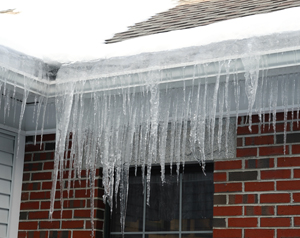 Prevent Ice Dam Damage This Winter
Prevent Ice Dam Damage This Winter
It’s still warm enough outdoors that the only ice you are thinking about probably is in your drink. As we get closer to winter, though, you might want to consider installation of roof and gutter de-icing cables to prevent ice dam damage to the exterior and interior of your home.
Ice dams are caused when heavy snowfall starts to melt on a roof because of heat escaping up through the house. When the runoff gets to the edge of the roof or the gutters, where the roof temperature is colder, it can refreeze. The ice buildup itself is not always a problem, but it can have a “damming” effect for subsequent runoff, trapping the water and forcing it to back up under the shingles and roofline. The result can be damage to your roof material, gutters and soffit and fascia, and eventually the moisture can contribute to mold, peeling paint and plaster or drywall damage to your ceilings and walls inside.
If you live in an area that’s only hit with one or two large snowfalls each winter, you can try and avoid ice dams by keeping your attic roof cold using insulation or properly placed vents to let the heat escape. If you have a one-story house, it’s also effective to use a specially-designed snow rake to pull heavy snow off of the edge of your roof. If your house is more than one story, though, that’s not really an option.
One of the best ways to prevent ice dams is electric heating cables, also called “heat trace” or de-icing cables. There are different types of systems available, but they all rely on the same basic premise — high-resistance wires are plugged into an outdoor, Ground Fault Circuit Interrupter (GFCI) Outlet and installed in a zigzag pattern along the roofline and/or inside of the gutters. De-icing cables can either be connected to power only when needed, or used as part of an automatic system that changes the heat output in response to the weather conditions.
De-icing cables work well on tall houses and those with steep roof pitches or hard-to-reach roof areas. They are also a good choice if you have only one section of your roof that tends to “grow” ice and icicles because of its directional exposure. Heat trace can also prevent large amounts of snow from collecting and then sliding off of metal roofs.
Enjoy the warm autumn weather, but remember that it’s easier to install a roof and gutter de-icing system now instead of waiting until things start to freeze up!

